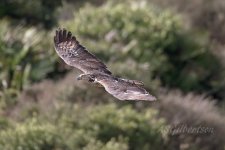I've discussed long distances elsewhere. Digiscoper Neil Fifer gave the advice to shoot birds rather 30m than 100m away. Danny Young / nzmacro, who focuses his FD 500mm or FD 800mm manually via Nex-7,
wrote: "I would never use anything at a 150 meters, not even the 800 F/5.6L".
For close birds, say 7m away, feather detail isn't hard to get. A bridge camera like the Canon SX50 can do it for stationary birds. The SX50 is still an option for 100-150m distances - until the birds take off. With 2-3 frames per second or speeds below 1/1000 sec it is hopeless to shoot raptor action.
I am interested in bird behaviour. Feeding goldcrests can eat 8-12 springtails per second. Sometimes we need a fast camera! Feather detail is not my goal, if I shoot raptors in a distance, but IQ is important. It would be nice to have a 500mm prime and your reach of 1120mm equivalent (vs my 800mm).
Fortunately I have
an upgrade path to 2295mm, if I win Euro 1000 in a lottery. o





